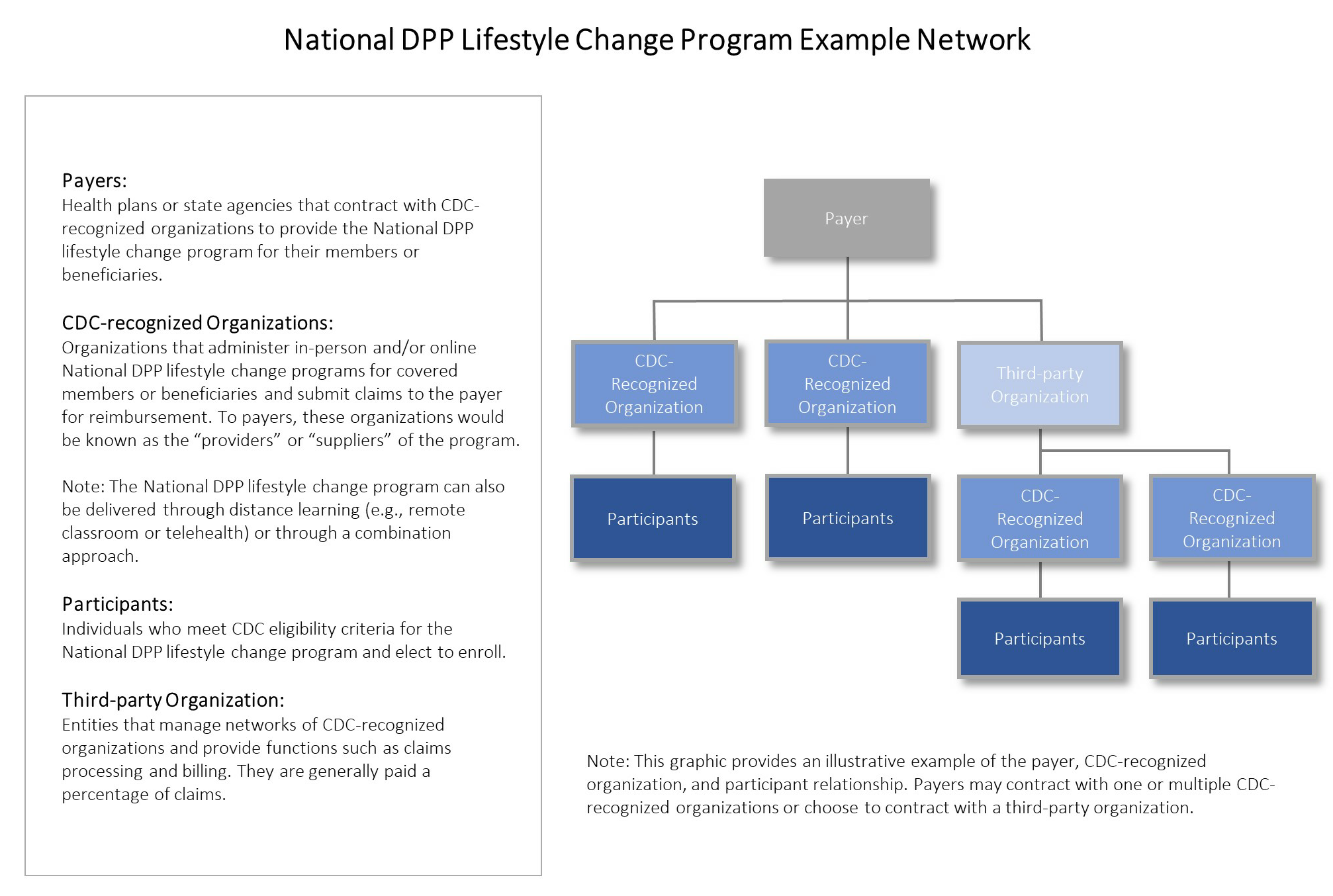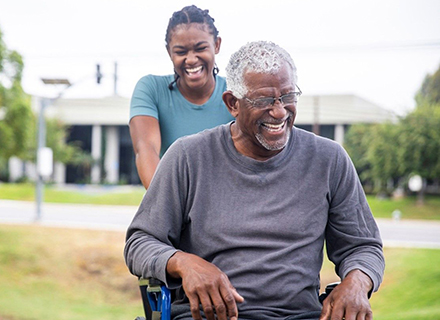Commercial Payers → Implementation → National DPP Lifestyle Change Program Delivery Options
National DPP Lifestyle Change Program Delivery Options
When covering the National Diabetes Prevention Program (National DPP) lifestyle change program, commercial health insurance plans and employers have several options for administering the program. These options include contracting with CDC-recognized organizations that provide the program:
- In-person. Yearlong lifestyle change program delivered 100% in person for all participants by trained lifestyle coaches, meaning participants are physically present in a classroom or classroom-like setting. Lifestyle coaches may supplement in-person sessions with handouts, emails, or reminder texts. Organizations that conduct make-up sessions online, via some other virtual modality, or over the phone are still considered to be delivering the program in-person. Note: some health systems that commercial plans or employers contract with may already offer the program.
- Online. Yearlong lifestyle change program delivered 100% online for all participants, meaning participants log into course sessions via a computer, laptop, tablet, or smart phone. Participants also must interact with lifestyle coaches at various times and by various communication methods, including online classes, emails, phone calls, or texts.
- Distance Learning. Yearlong lifestyle change program delivered 100% by trained lifestyle coaches via remote classroom or telehealth (i.e., conference call or Skype) where the lifestyle coach is present in one location and participants are calling or video-conferencing in from another location.
- Combination. Yearlong lifestyle change program delivered as a combination of any of the previously defined delivery modes (1 – 3 above) by trained lifestyle coaches.
- Contract with a third-party organization or an umbrella hub arrangement (UHA) to create a network of CDC-recognized organizations that provide the National DPP lifestyle change program.
- Seek CDC recognition and provide the program themselves. Organizations interested in offering the program can use the American Medical Association’s National DPP Lifestyle Change Program Budget Considerations Tool to estimate the cost implications of offering the program.
Click here for a list of CDC-recognized organizations in your state. For a map comparing the availability of National DPP lifestyle change program classes from organizations with full or pending CDC-recognition status, click here. For examples of delivery options currently being used by employers, see the Commercial Coverage Landscape and the Employer Coverage Landscape pages of the Coverage Toolkit.
The CDC developed the Find a Program tool and the Find a Program fact sheets as resources for program participants and CDC-recognized organizations. The Find a Program tool provides new and returning National DPP participants an on-demand list of available lifestyle change programs offered in a specified area. The Find a Program fact sheet for CDC-recognized organizations provides information to navigate the Diabetes Prevention Recognition Program (DPRP) Data Submission Portal to update their organization’s public class information.
When determining what types of CDC-recognized organizations to include in their network, commercial plans and employers should consider the unique needs of their members or workforce, commercial insurance rules and authorities, current delivery system structures, provider credentialing, network adequacy, and other contracting standards.
Provider Status and Other Commercial Plan Considerations
Providers should be aware that some commercial plans may have their own credentialing requirements for contracted providers. These requirements vary by plan and may vary by provider type as well. In general, these requirements could include verification of training, state licensure, professional licensure (where appropriate), CDC-recognition, work history, and verification of any prior sanctioning activities.
Commercial plans should note that CDC-recognized organizations must meet Diabetes Prevention Recognition Program (DPRP) standards and some plans leverage these standards as the credentialing requirements for this program (this could translate to proof of pending, preliminary, or full CDC recognition). The DPRP plays a critical role in assuring that organizations can effectively deliver the evidence-based lifestyle change program with quality and fidelity.
National DPP Lifestyle Change Program Example Network

CDC-Recognized Organizations Providing In-Person Lifestyle Change Programs
In-person National DPP lifestyle change programs are provided by a variety of organizations, including but not limited to hospitals, health plans, YMCAs, diabetes self-management education and support (DSMES) programs, pharmacies, Cooperative Extension Centers, local health departments, community-based organizations, and faith-based organizations. Offering the program at the worksite has shown to be an effective approach for employers.
Note: Some health systems that commercial plans or employers contract with may already offer the program. Commercial plans and employers should review the list of CDC-recognized organizations in their state to determine if potential partnerships already exist.
Click here for a list of CDC-recognized organizations in your state.
Working with Community-Based Organizations
Partnering with community-based organizations (CBOs) to provide the National DPP lifestyle change program has the potential to activate individuals to be more engaged in their care and enable providers to better address clinical issues by leveraging the expertise and skills that exist in the human services industry.
The Partnership for Healthy Outcomes studied over 200 community partnerships between CBOs and health care organizations. The resulting report indicated the following core components of community partnerships:
- Develop unified goals
- Determine a common understanding of where on the integration spectrum the partnership lies: communicating, coordinating, collaborating, or integrating.
- Create a formal agreement
- Establish a funding model
- Maintain a level of data sharing
- Cultivate mutual trust
Challenges
Some of the greatest challenges that may exist within partnerships with CBOs, as indicated by the Partnership for Healthy Outcomes and the Illinois Public Health Institute, are:
- program funding and sustainability,
- data sharing and submission, and
- inexperience with health industry processes.
Many community partnerships found that covering their full, ongoing costs is a primary challenge. Even with insurance reimbursement, many must still subsidize costs through other funding sources, such as grants. Calculating and documenting true program costs is one key to informing return-on-investment calculations, developing a sustainable funding model, and building trust between partners.
Technology challenges exist for both health/insurance organizations and CBOs when working together. For instance, many claims systems are not configured to receive claims-based codes from non-traditional providers. This limits the payment and process models that may be used when implementing the National DPP lifestyle change program with CBOs. In addition, some CBOs may have limited technological capability to share various levels of data, to abide by the Health Insurance Portability and Accountability Act (HIPAA), or to efficiently assess results. Health care organizations, including payers, may consider providing data and analytical support to mitigate some of these challenges or contract with a third-party organization or UHA that can manage and provide some of these needed data functions for the CBOs.
Most CBOs have very little experience with many of the processes used in the health care industry and may need some guidance in carrying them out. Some of these processes may include enrolling as a Medicaid provider, submitting claims or invoices, negotiating contracts with payers, understanding data security protocols, or receiving referrals from and working with providers.
Partnership Assessment
The Partnership for Healthy Outcomes also developed a Partnership Assessment Tool (accessed here) to help you identify strengths, gaps, challenges, and opportunities and help guide your conversations to ensure a strong and effective partnership.
CDC-Recognized Organizations Providing Online or Distance Learning Lifestyle Change Programs
Several organizations have experience providing the National DPP lifestyle change program online or via a distance learning platform and, like in-person programs, understand program requirements, quality standards, and data reporting.
Offering the National DPP lifestyle change program online or through distance learning may increase access to the program, particularly in rural areas. Additionally, a recent study found that participants who received the National DPP lifestyle change program through telehealth videoconferencing (distance learning) had similar rates of participation and achieved similar weight loss as participants who attended the program in-person.
Some CDC-recognized organizations that provide the program online use a smart-phone or tablet-based platform, which may have broad reach among the commercial plan population. As with in-person organizations, online or distance learning CDC-recognized organizations need to comply with HIPAA and any applicable commercial insurance rules and regulations.
Click here for a list of online, or combination in-person/online CDC-recognized organizations in your state. Click here for a list of evidence on the effectiveness of in-person and online delivery of the National DPP lifestyle change programs.
CDC has developed a Virtual Recruitment Toolkit in response to the COVID-19 pandemic. Virtual recruitment has become increasingly important as a result of the public health emergency and as digital technology and the internet have become universal tools to communicate with people. The toolkit offers guidance on how to recruitment program participants in a virtual or remote environment. Concurrently, CDC developed a published Guidance for Virtual Delivery of the National DPP, available here.
Third-Party Organizations
Some commercial plans and self-insured employers use a third-party organization to assist with program delivery. Third-party organizations can manage networks of CDC-recognized organizations, so the commercial plan or employer doesn’t have to execute individual contracts with each organization, and can provide functions such as claims processing and billing. They may be paid a percentage of claims. Third-party organizations acting in this capacity may be called a number of terms, including UHA, third-party administrator (TPA), provider integrator, or management service organization (MSO), all of which connect CBOs with health care payment systems to pursue sustainable reimbursement for the National DPP lifestyle change program.
Seeking CDC Recognition
Commercial plans and employers can become CDC-recognized themselves, which may simplify network development and contracting. Some commercial plans have chosen to become CDC-recognized organizations as part of “disease management programs” they already provide as a service to their members.
Organizations can apply for CDC recognition if they meet CDC’s Diabetes Prevention Recognition Program (DPRP) standards. To ensure high quality and impact, CDC’s DPRP plays a critical role in assuring that organizations can effectively deliver the evidence-based lifestyle change program with quality and fidelity. CDC only recognizes programs that meet standards such as using a CDC-approved curriculum, which helps participants meet intensity and duration requirements to achieve the 5‒7% weight loss goal.
The DPRP, along with some state and local public health departments, also provide technical assistance to organizations to help them achieve and maintain program recognition.
- For more information on standards for CDC recognition, click here.
- For the DPRP application form, click here.
CDC-recognized organizations are regularly monitored and evaluated. They must track results and send data to CDC to show that they are meeting the recognition standards. CDC reviews these data and provides feedback to the program on their recognition status in addition to help in troubleshooting potential problems that could be keeping the organization from achieving recognition.









